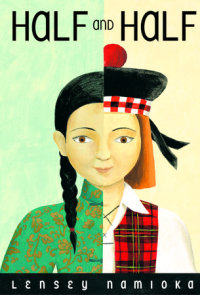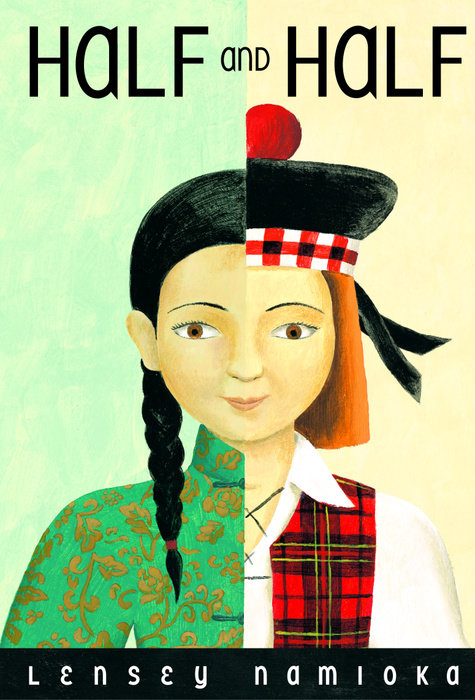one
“Your form isn’t complete, Fiona,” said the recreations director. “I can’t let you enroll in the folk dancing class until it’s completely filled in.”
The recreation center is located at a park not far from my school. For years the center had been used for adult education classes, such as pottery and language lessons. Recently the building was remodeled and expanded, and they started having classes for young people, too.
When I heard there were folk dancing classes, I immediately went over to enroll. I had never filled out one of their forms before, and I didn’t know what the director meant by the form not being completely filled in. I looked it over again.
Name:Fiona Cheng
Age:11
Address:2134 Hillside Blvd. E.
Seattle, WA
Class:Folk Dancing
It looked good to me.
“You didn’t check a box for race,” she said. “To get government funding, we have to let them know how many kids we have in each of the race categories.”
This was a problem I’d bumped into before, but I still wasn’t sure how to handle it. I took the form from her. “I’ll…
one
“Your form isn’t complete, Fiona,” said the recreations director. “I can’t let you enroll in the folk dancing class until it’s completely filled in.”
The recreation center is located at a park not far from my school. For years the center had been used for adult education classes, such as pottery and language lessons. Recently the building was remodeled and expanded, and they started having classes for young people, too.
When I heard there were folk dancing classes, I immediately went over to enroll. I had never filled out one of their forms before, and I didn’t know what the director meant by the form not being completely filled in. I looked it over again.
Name:Fiona Cheng
Age:11
Address:2134 Hillside Blvd. E.
Seattle, WA
Class:Folk Dancing
It looked good to me.
“You didn’t check a box for race,” she said. “To get government funding, we have to let them know how many kids we have in each of the race categories.”
This was a problem I’d bumped into before, but I still wasn’t sure how to handle it. I took the form from her. “I’ll finish it later,” I muttered, and quickly left the recreation center.
On the way home, I tried to decide on the best way to complete the form. I had to check one of the boxes that said, “White,” “Asian,” “Black,” “Hispanic,” “Native American,” or “Other.” None of them would be right, though, because I’m not any one of those things. I’m half and half: my father is Chinese and my mother is Scottish. I couldn’t just check either “White” or “Asian” since I’m half of each.
I suppose I could have checked the box for “Other,” but I didn’t want to. It would make me feel like an outsider, a weirdo who didn’t belong anywhere. I wanted to fit in like everyone else. Why didn’t they have a box for people like me, who were half and half?
When I got home, Mom was in the kitchen, pouring herself a cup of tea. She teaches math at the university, so she’s often home in the afternoon. She drinks tea instead of coffee, even though we live in Seattle, the nation’s coffee capital. Tea is cheaper than coffee since you can use the tea bag over again. You see, Mom is very thrifty.
She says it’s because a mathematician’s aim when proving a theorem is to use as little as possible to prove as much as possible. In other words, you always spend a teeny bit to get a whole lot. After doing this for years and years, you wind up being ver-r-r-y thr-r-r-ifty.
I took a seat at the kitchen table. “Mom, what am I?” I asked.
She frowned. “What do you mean? You’re Fiona Cheng, last time I looked.”
“I’m not asking you who I am,” I said. “I’m asking you what I am.”
“What brought this on?” asked Mom, sipping her tea and looking at me over the rim of the cup. I think she suspected that the problem had something to do with our family being racially mixed. It’s not something the two of us often discuss.
I told her about the form I had to fill out for the folk dancing class. Mom didn’t answer right away. The expression in her hazel eyes didn’t tell me much. “Why not check two boxes, one for ‘Asian’ and one for ‘White’?” she suggested after a while.
“I don’t think they’ll accept that,” I sighed. Suddenly I became angry. “Why do grown-ups always have to sort people into boxes anyway?”
“They like to do that, don’t they?” said Mom. “But you can’t always sort people by the way they look.”
To be honest, though, I sorted people, too. Whenever I met another racially mixed kid for the first time, I thought about percentages. I said to myself, “Let’s see . . . 65 percent/35 percent,” meaning that he looks 65 percent one race and 35 percent another. Later, when I got to know the person well, I’d forget about the percentage business for the most part. But it was a tough habit to break completely. Maybe I get it from Mom’s love of mathematics?
Since Mom wasn’t any help, I went upstairs to Dad’s studio. He writes and illustrates children’s books. His best-known books are a series about a dragon living in ancient China. Dragons are supposed to do all sorts of good things, like bringing rain to lands suffering from drought. But Dad’s dragon is secretly scared of water, and just about everything else, too. So how can his dragon present a majestic and fearsome image to the world while preserving his shameful secret? Each of Dad’s books puts his dragon in a tight spot, but the dragon always manages to get out of it somehow.
I knew Dad was working on the illustrations for his latest dragon book. Normally I don’t like to interrupt him, but this time I needed help.
Dad looked up from his drawing board and placed a large sheet of paper over the picture he was working on. He always does this automatically whenever anyone comes in while he’s in the middle of something. He hates having people look at his work before he’s satisfied with it.
“What’s up, Fiona?” he asked.
I asked him the same question I had asked Mom. “I have to fill out a form for the folk dancing class, and they want to know what race I am. Should I check the box for ‘Asian,’ or the box for ‘White’?”
Dad looked at me. His eyes are a dark brown, just like mine. “Would it bother you to check the box for ‘Asian’?” he asked.
“Of course it wouldn’t,” I said quickly. I’ve always known that I look more Asian. I have my dad’s brown eyes, straight dark hair, and dark skin. By checking the box for “Asian,” I would be telling him that I belonged with his people.
“It’s just that I have to be accurate,” I told Dad. “The recreation center has to report the number of kids they have in each race to get money from the government.”
“Then you should do whatever feels right to you,” said Dad.
The problem was that I didn’t know what felt right to me.


